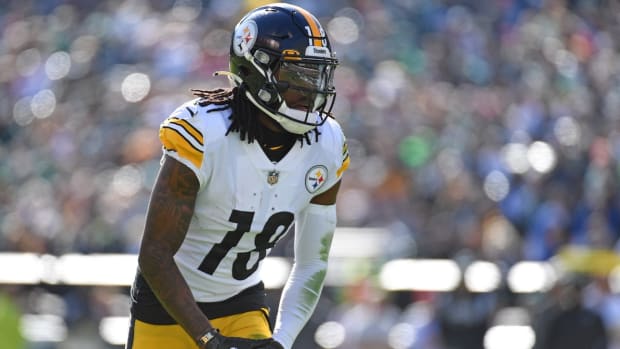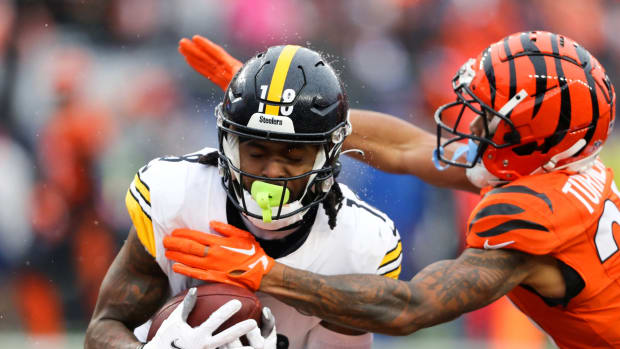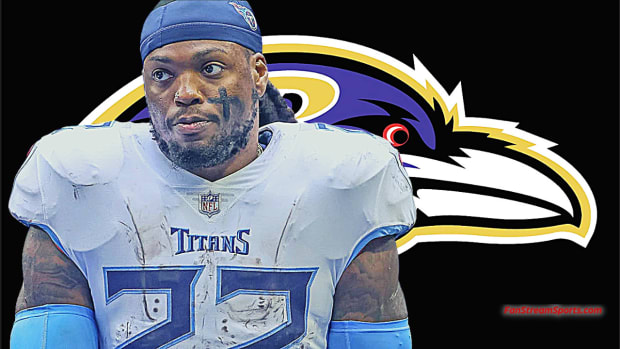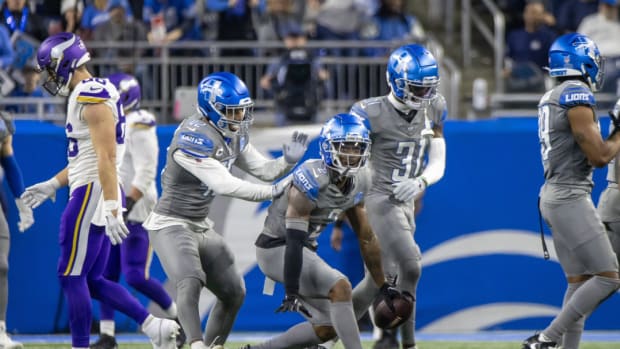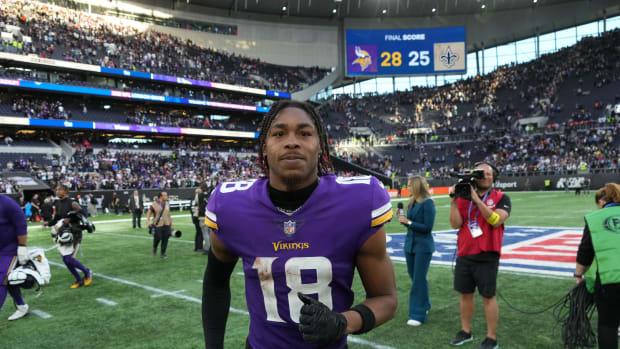Rainy Pro Day Does Nothing to Dampen Enthusiasm for Sam Darnold as Likely Top Draft Pick
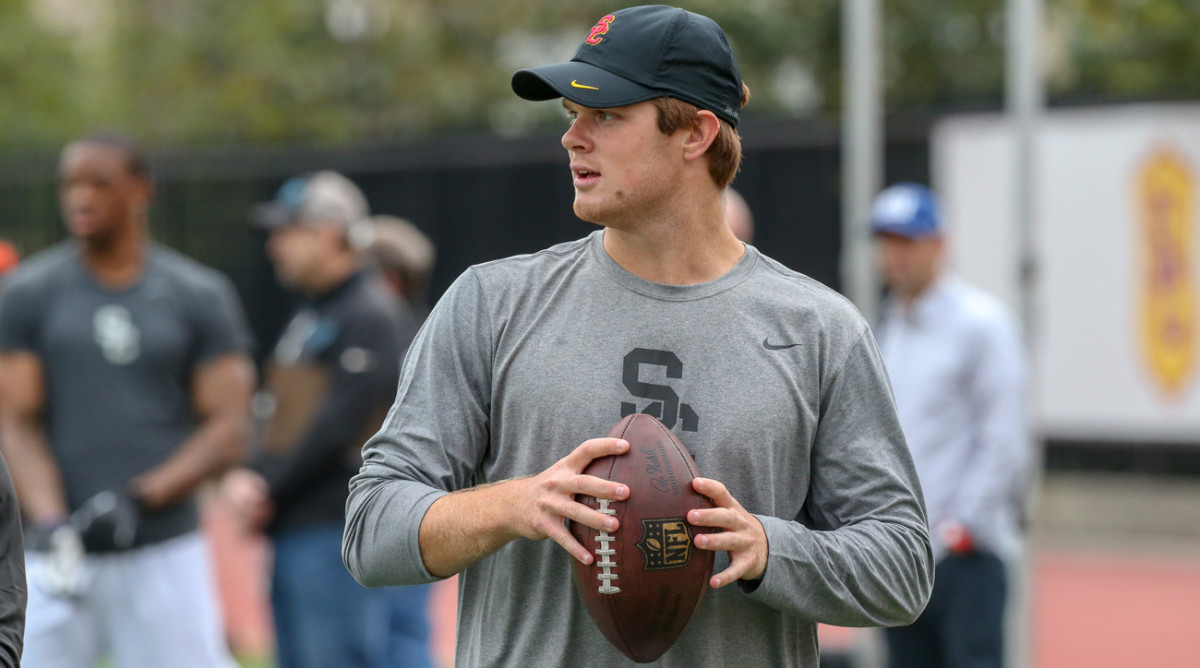
The USC staffer who approached Sam Darnold and his coach, Jordan Palmer, before the Trojans’ pro day on Wednesday had all the quarterback’s best intentions in mind a few hours before the workout started. After all, with 32 NFL teams coming onto campus, most players in that spot would want to avoid the risk that was posed by an oncoming, exceedingly rare Southern California downpour.
Or at least, that’s how the poor guy saw it.
USC staffer:Hey guys, the weather patterns show that it’s gonna start raining right when we’re getting ready to throw. So we’re gonna move everything around, and have you throw before it rains and then have the O-line/D-line workout in the rain.
Darnold: Why are we doing that?
USC staffer:Well, so you don’t have to throw in the rain.
Darnold, looking to Palmer: No, we’ll just throw in the rain, right?
Palmer: Yeah.
Darnold: Perfect. I don’t care if it rains. I’m trying to go to Cleveland.
And in the coming hours, it was clear to all the teams drafting behind the Browns that Darnold had moved one step closer to getting there. Post-combine buzz held that he’s the leader to land in Northeast Ohio in late April, and the 20-year-old, who does come with questions, looked every bit the part of No. 1 overall pick on this stage.
The Browns haven’t done much to tip their hand yet, and they’ll do as much work on Wyoming’s Josh Allen, Oklahoma’s Baker Mayfield and UCLA’s Josh Rosen as they will on Darnold. But it’s clear which way the wind’s blowing.
“He’s going number one,” said one AFC exec, via text from L.A. “Everyone out there today saw the Browns’ franchise quarterback.”
In this week’s Game Plan, we’ll explain what looked like an overpayment for one new Niner, and what the market might be for a departing Niner; we’ll check in on the NFL’s efforts overseas; preview some of what you’ll hear coming out of the league meeting next week; and check in with Ryan Pace to illustrate the effort he’s made to create the best environment possible for last year’s third overall pick.
But we’ll start with the four-horse race to be the first quarterback taken, and examine just how Darnold showed the teams in attendance—and in particular, the Browns—exactly what they needed to see. It’s fair to say that Palmer had a clue as to what Hue Jackson was looking for, because Palmer has known the Browns coach since he was an eighth grader and Jackson was recruiting his brother Carson to USC.
First, though, Jordan Palmer offers a warning.
“I’m the guy that runs the pro day that’s sitting here saying: That’s actually not that huge a piece to the puzzle in my opinion,” he explained. “The time that he spends one-on-one with the Browns is more important than today. But with Sam, yeah, if you’re trying to convince the team that has the No. 1 pick that you’re their guy, today was a workout that should suffice.”
Palmer’s goal with all these workouts is, in his words, to “highlight the highlights and address the concerns.” And as is the case with every quarterback, there were specifics goals in this circumstance. Here those are in Palmer’s words.
• Highlight Darnold’s anticipation, touch and feel for throwing guys open. “I wanted to move him around. I backed into him like a tackle getting bull-rushed, so I could manipulate where I wanted him to go, and put him in a position to have to throw off-schedule. When you do that and you’re late, especially on over routes to the sideline, you have to get it up early because you’re running out of time and space. So he makes a really subtle movement, and throws it to a spot. He was money today on that.”
• Highlight throwing on the run.“On the run, he’s really, really accurate. So we showed that. It was a great day with that. It was just barely raining when we started and then turned into a torrential downpour. No flinch whatsoever, ice water through his veins.”
• Address footwork.“When a quarterback has poor footwork, you have to look at the system he’s in and how he’s being asked to do things. It’d be different if he wasn’t coachable, or he wasn’t doing what his coach was asking him to do. That wasn’t the case. We did pretty much every different type of play-action that you’ll see in the NFL—inside zone, outside zone, counter-action, we had about eight different play-actions today. And we were predominantly under center. The only reason I even put him in gun was if I need a back offset for something.”
• Address arm strength.“I don’t get it, but some people question his ability to drive the ball down the field. We obviously addressed that—he drove some balls down the field really well, and finished on the sideline with a lot of velocity, a lot of energy at the end of his throws. And then I moved him around quite a bit at the end, and had him chuck it deep, and he threw one 65 at the end of the workout, which is plenty.”
• And empty the tank. “The biggest stage you’re going to get in the offseason ever is a top pick performing at a pro day in front of his former teammates, his school, his family and NFL suitors. All you really want them to do is show the best version of themselves, whatever that looks like. I certainly didn’t go into the day wanting to complete a certain percentage of the passes, I don’t give a s--t about that. I wanted him to show the best version of himself, and he definitely, definitely did that.”
NFL Mock Draft Vol. 3: Two Draft Day Trades, Four QBs Lead Things Off
And NFL teams agreed. I had a personnel chief for one team text, “He looked good, threw the ball well in the rain, moved outside the pocket well, as expected. The tape will always trump any scripted workout in shorts and t-shirts. But it was a good workout, which checks the box.”
A head coach in attendance added, “Average from the pocket but really gets you excited when he’s on the move. He can create and make unorthodox throws, and that’s the real NFL. It’s all on tape, too.”
As we talked, Palmer was driving with his dad to LAX for an afternoon flight to Wyoming for another pro day, this one starring Allen, another one of the QBs he’s working with pre-draft. So as satisfied as he was with Darnold, he wasn’t going to call for the Browns to rush the card to the podium. Nor could he.
“Josh is gonna try to do the same thing on Friday, and I think he’s going to do the exact same thing,” Palmer said, “and put Cleveland in one of those unique situations where they’re going to get to choose between diamonds and gold.”
But there was one thing I had to ask him about, that was particularly interesting on Wednesday, and that was the image of Darnold’s parents talking in the stands with Cleveland owner Jimmy Haslam.
“Did they show that?” Palmer said, laughing. “That’s awesome.” He added, “Outside of me, I’m in the car with my dad, if it was ever a good thing to have someone meet your parents, his parents are rock stars.”
Lots of informed people left L.A. on Wednesday thinking the Darnolds’ son is one, too. Or maybe just had it confirmed for them.
FIRST AND 10
1. The Eagles’ additions of Haloti Ngata and Michael Bennett, who are a combined 66 years old, may or may not workout. But I applaud the premise of the moves, which is to build strength on strength, something the Giants did on their defensive line back during their Super Bowl years. The idea is that the last thing a club can afford is for a couple injuries to turn a team strength into average-or-worse section of the roster, and guarding against that is something good franchises have habitually done.
2. Ill-timed injuries or health revelations usually aren’t killers for draft prospects, but they don’t help anyone’s cause either. Ohio State’s Billy Price had surgery after tearing his pec at the combine, and the ailment has opened the door for Iowa’s James Daniels to pass him as the best center in the draft. And Michigan’s MauriceHurst, a shorter, disruptive defensive tackle, had a heart condition detected by doctors in Indy, and there’s a feeling it could cost him a little in draft position—these are the types of problems where owners can get involved.
3. I don’t mind the revision of the catch rule; I don’t mind giving a little subjectivity to the officials. That said, whatever they do, I think it’s worth taking a look at slowing down the amount of changes we’ve had in the rules. NFL speed makes the game amazingly difficult to decipher, much less officiate, at field level. Adding rule after rule sure won’t make the referees’ jobs any easier.
The 2018 NFL Draft Could Very Well Feature Four Quarterbacks in First Five Picks ... Or Not
4. Along those lines, I’ll be interested to see how the Jets’ proposal to change pass interference goes over. As it’s written, the new rule would make defensive pass interference a 15-yard penalty “unless the foul is determined to be intentional or egregious by the officiating crew.” Where to draw the line will be challenging. The competition committee, by the way, is expected to release its rules recommendations on Thursday.
5. The Raiders’ decision to hang on to Marshawn Lynch is interesting. New coach Jon Gruden has made moves to clean up the locker room—whacking MichaelCrabtree was one—but leaving Lynch there means bringing back a player who was mercurial, inconsistent and never seemed to fully buy into Jack Del Rio’s program. Making it tougher, his popularity among his teammates made it easy for him to bring others with him. Maybe Lynch will respond differently to Gruden. Either way, this merits watching.
6. With Jets QB Teddy Bridgewater declining Wednesday to comment on the state of his knee, we’ll reiterate that the $500,000 signing bonus that he already collected was the only piece of his one-year deal that was guaranteed. He should pick up a $500,000 workout bonus too, but he has to make the team to get anything else, making for a wide range of what he’ll take home from his new team. It’s $1 million if he’s cut, $6 million if he’s the season-long backup and up to $15 million if he starts and hits his incentives.
7. I really love what the Bills did over the past couple weeks. They determined that Tyrod Taylor wasn’t their future, and still were able to shed his $16 million figure for 2018 and somehow get the 65th pick in the draft. And then they signed AJ McCarron, who gets a $5 million base for 2018 (with incentives available). So in that transfer, in which they feel like they may have gotten better at QB, they save up to $11 million and get an early third-rounder for their troubles.
8. Ndamukong Suh’s earning power is a good example of what the players have lost with outsized rookie deals gone. In Suh’s final years in Detroit, the team restructured his deal several times, which kept making his final year cap number bigger. That made tagging him—remember, the tag is 120 percent of your previous year’s cap number, if that number is greater than the assigned tag—logistically impossible for the Lions. So they had to let Suh hit the market, and he blew the market up, and is now out there again. Without the big rookie deals? It’s much easier to tag players who were drafted high a few years prior.
9. Great nugget that I picked up in researching my mock: Dave Gettleman had no history of trading down during his four years as Panthers GM. Doesn’t mean he won’t. It does tell you that he values his first-rounders. It’ll be interesting to see if the new Giants GM sticks to his guns here, given what he should be able to get for the second pick.
10. Fun item on the NFL Annual Meeting Agenda: NFL100, the league’s celebration of its 100th season, which is the 2019 season. The planning for that is now underway, and if the celebration of the 50th Super Bowl was any indication, you can expect to see the league make reference of its impending anniversary a few times.
FOUR DOWNS
1. Explaining McKinnon and Richburg. One thing I love about the way the 49ers are building under GM John Lynch and coach Kyle Shanahan: Every move is made with purpose, because what Shanahan wants is so clear. And the first week of free agency was a great example. To illustrate that, I’ll take you to a conversation I had with Brian Hoyer a few years back, where he relayed a talk he had with Shanahan, then Cleveland’s offensive coordinator, about what his offense needed from a personnel standpoint.
“You need a big-time, play-making ‘X’,” Hoyer said. “Kyle always wanted someone who was really, really fast. .. He wants two pass-catching backs. … He wants a move-the-chains possession receiver. … He wants a smart, athletic center, who can take the mental burden off the quarterback.”
Three moves stick out that fit that perfectly. First, the Niners re-signed Marquise Goodwin (three years, $20.3 million), who fills the need for a burner like Taylor Gabriel did for Shanahan in Cleveland and Atlanta. Second, the Niners re-upped center Daniel Kilgore on a three-year, $11.78 million extension, while backing off the first bonus in case there was a better option at the position. Turns out, there was—ex-Giant center Weston Richburg agreed to a five-year, $47.5 million deal with San Francisco on the first day of free agency, and, as a result, the Niners shipped Kilgore to Miami before that bonus came due. And third, San Francisco extended itself in bringing in Jerick McKinnon on a four-year, $30 million contract, which is a lot of money for a back who’s more jack-of-all-trades than workhorse. In that case, as I understand it, Shanahan kept giving the Niners personnel department the green-light to continue pushing the financial envelope and close the deal. Did they overpay? Maybe. But that’s free agency.
The key here is the vision for the talent that will surround Jimmy Garoppolo in Shanahan’s offense. And that vision, I think, has done plenty to accelerate the rebuilding process in San Francisco, to the point where the 49ers could well be a contender this season.
2. Eric Reid’s still out there, for the signing. It’d be naïve to think Eric Reid’s national anthem protests throughout the 2017 season, and his resistance to follow with the Players Coalition’s effort to work with the league, are a total non-factor a week into free agency. It’s there. Everyone knows it. But as is the case with many guys who remain unsigned right now, there’s more than one reason why the ex-Niners safety isn’t on roster. And a big one is how slow the safety market has been to develop.
As this was filed, ex-Saint Kenny Vaccaro, ex-Charger Tre Boston, ex-Steeler Mike Mitchell and ex-Cardinal Tyvon Branch remain unsigned, and the guys who have signed haven’t exactly made a huge splash. Tyrann Mathieu, who has corner flexibility, did a one-year, $7 million deal in Houston, and Morgan Burnett’s making less than $5 million per on a three-year deal in Pittsburgh. What gives? Well, more money is going to pass rushers and cover corners, with more teams believing, in a passing league, they can find affordable ways to fill middle-of-the-field positions. That is why the Broncos could trade an aging Aqib Talib and Rams could move a beat-up Robert Quinn without even touching their pricey contracts.
Conversely, consider this: Buffalo’s safety tandem was the NFL’s best at picking the ball off last year (10 interceptions combined), and Micah Hyde came to Buffalo last year on a mid-market deal ($6 million per), with Jordan Poyer having signed the same day for less than that ($3.25 million per). As one NFC pro scouting director said, “In today’s defenses, you can hide the safety if you need to.” So that’s absolutely a part of it, too.
But as for whether Reid can play, the answer to that question is yes. Last year the Niners employed him mostly in the Kam Chancellor role within their Seattle-style defense, and he maintained the versatility to play some deep and even some at linebacker, when the injury bug hit. He’s not great in any one area, and he’s had concussion issues, but he can do a lot of different things. My guess is that once the safety market starts moving, Reid will find a home. If he doesn’t, it’s fair to ask some questions.
Eric Reid Is Still a Free Agent. He Shouldn’t Be
3. NFL China update coming next week. As usual, there will be an international update at next week’s Annual Meeting, and there are three topics on the agenda—future games, the ongoing international player program and, again, China. So where does the NFL stand on going to the Far East? Initially, the plan had been to explore having a game this September in Beijing, but that was scuttled for a couple of reasons.
One, the NFL didn’t want the game to be a one-off. They want to try to replicate the London model of growing an event annually, if possible, when they’re making the investment to go to a new market overseas. And to be able to go annually, the game has to reach a certain popularity in the region. Two, there are the logistical issues in getting teams across the Pacific and back, the effect it would have on competitive balance, and how the game would be broadcast in the States with the difference in time-zone certain to create a challenge in drawing a decent rating.
For now, teams I’ve talked to seem to believe 2019 is unrealistic as well, especially considering the amount of manpower that’ll be put into the celebration of the league’s 100th season. And that takes us to 2020, when two West Coast teams—the Rams and Raiders—will be opening new stadiums and likely far less willing to give up home games to be part of this grand experiment.
We reported in the fall that, for now, the NFL’s focus is on trying to get people actually playing the sport in China. And it seems like that could be the focus for a while, since there’s no great sign that the league is moving closer to surmounting the challenges it faces in reaching the pretty ambitious goal of playing a regular-season game over there.
4. Patriots try to get more out of less. You can’t take the huge loss of Nate Solder out of the equation, but if you could, the Patriots might have gotten out of the first week of free agency on level ground. Going: Danny Amendola, Alan Branch, Malcolm Butler, Dion Lewis. Coming: Jeremy Hill, Danny Shelton, Cordarrelle Patterson, Adrian Clayborn. And among the arrivals, New England has three former first-round picks and an ex-second-rounder, which means there’s at least some belief in Foxboro in the talent that made those guys high selections in the first place.
There are, of course, reasons why the four newcomers were available. Patterson is a great return man and has some value as a gadget player on offense, but the Raiders felt like he’d struggle with Jon Gruden’s intricate offense and wordy play calls. Hill is a smart, talented, bigger back who ran a little bit too much like a 190-pounder for the Bengals’ tastes, then got beaten out by Joe Mixon. Clayborn was a favorite of the staff in Atlanta, and had value as a strong-motored situational pass-rusher, but simply cost too much to keep as a backup behind Takk McKinley and Vic Beasley. And Shelton was a solid run-down player who never evolved as a pass-rusher, and thus was a tough fit for Gregg Williams’ defense.
The question is how much of their abilities can Bill Belichick’s group squeeze out of these new additions. At any rate, a good on-the-field return from those four could make a big difference, particularly if the Patriots can replace Solder adequately and solve the Rob Gronkowski situation.
LESSON OF THE WEEK
Ryan Pace didn’t need another reason to be jacked about his quarterback’s future. But after a flurry of free-agent activity last week, the Bears GM got it from Mitch Trubisky anyway.
Maybe more meaningful? The incoming talent—receivers Allen Robinson and Taylor Gabriel, and tight end Trey Burton—was just as excited as the quarterback.
“Yeah, you could tell Mitch was excited, just through a quick text,” Pace said from his office the other night. “He’s fired up, and I know they’re all talking to each other. Today, Taylor was walking around the building in a Trubisky jersey. They’re all ready to go. It’s cool when you sense from the guys that we signed, how excited they are to play with him.
“And Mitch is equally excited, adding these pieces to what we already have.”
We keep getting these reminders, and there’s no need to overcomplicate it. Even after a year in which three of the final four teams left were led by a couple journeymen and a supposed draft bust, the lesson is there for everyone: The NFL is more about the quarterback now than it ever has been. Just look at what’s happened over the last six weeks alone …
• The Niners made Jimmy Garoppolo, he of the eight career starts, the highest-paid player in league history, inking him to a five-year, $137.5 million deal.
• The Vikings trumped that, doing a three-year, $84 million deal with Kirk Cousins, while breaking new ground in fully guaranteeing the whole thing.
• The Chiefs gave Patrick Mahomes a shiny, if overpriced, new downfield piece in Sammy Watkins—forking over a three-year, $48 million deal for him.
• The Texans gave multiyear deals to guards Senio Kelemete and Zach Fulton and made a run at left tackle Nate Solder (who ultimately ended up with the Giants) to better protect Deshaun Watson.
• The Jets traded three second-round picks to jump from 6 to 3, ensuring they’ll be in position to draft a top-tier quarterback.
So I asked Pace, is it too simplistic to say 2017 was about finding the quarterback for the Bears, and 2018 has been about building infrastructure around him?
“No, that’s accurate,” he quickly answered. “The hardest piece of this whole thing is to find the quarterback. We feel like we’ve done that. And so now, it’s surrounding your most important asset, your quarterback, with weapons so he can be successful and they can grow and develop chemistry together. And not just the quarterback and those players, but all of them and the new offensive staff. And they’re all young.”
And while Chicago’s actions have been interesting, its moves are just a part of a trend we’re seeing everywhere to over-invest in getting a quarterback, then over-invest in getting everything around him right.
Each of the six first-round quarterbacks drafted in the past two years were landed as part of a team trading up. The five who are starting going into 2018 have head coaches who were hired with extensive background working with quarterbacks as assistants. And last year, we saw the Eagles give Alshon Jeffrey to Carson Wentz, and the Rams give Robert Woods, Watkins and Cooper Kupp to Jared Goff.
That’s where Houston, Kansas City and Chicago are now—stocking the shelves for a sophomore quarterback. And so Pace gave us some insight into the steps the Bears took over the last two months to make it happen.
• Finding the coach. Four of the six candidates that Pace interviewed had background in coaching quarterbacks, something he says now was more just how things lined up this year. The priority was, in his words, to hire “the best leader and the best man.” He found it in coach Matt Nagy. Pace also concedes that the influence of all his years in New Orleans, seeing Sean Payton and Drew Brees together, absolutely crept into the search process.
“I try not to talk about New Orleans so much anymore, because it’s all about here now, but we all learn from our previous experiences,” Pace said. “When you think about, you look at Drew and Sean now, the levels they’re on, all they have to do is look at each other. The heights the offense has gone too, because of the cohesion between those two guys, that’s something everyone is striving for.
“It’s gonna be fun to have Mitch and Matt paired together long-term. … And a lot of times, if you have a successful play-caller, well, he’s gonna get plucked out of there to become a head coach elsewhere and then you break up the continuity between him and the quarterback. That’ll never happen here. So that’s the attractiveness of it.”
• Building a vision. The Bears struck a deal with Nagy in early January in Kansas City, and the coach and GM flew together on the McCaskeys’ plan back to Chicago. They didn’t necessarily mean for it to be this way, but that’s when the groundwork for March really began to take shape.
“It’s the first time he and I can just exhale and talk football,” Pace said. “The very first conversation we had involved how much he values the ‘U’ tight end, how productive the offense can be for those guys. And we went through it—who are some of those guys in free agency. And then all of the sudden, here’s Trey Burton.”
What stuck out to Pace was how specific Nagy was for each skill position. So Burton became the target as the move tight end, to pair with the supersized Adam Shaheen. Robinson was the big, smart route-runner who could shield defenders. Gabriel was the game-breaker. Each would be used to attack another level of the defense. And the scheme would work to do that too.
• Filling the staff. We mentioned a couple weeks back what a coup getting line coach Harry Hiestand from Notre Dame was. But as Pace explains it, the hire of former Oregon coach Mark Helfrich as offensive coordinator was a priority, too. It’s an addition that the Bears feel will help maximize Trubisky and others who worked in spread concepts as collegians.
“Matt was passionate about Helfrich from the very beginning,” Pace said. “They’d been on each other’s radar for a long time. Matt likes some of the outside-the-box thoughts he’s gonna bring from college. I’ll go down there at night right now, and Matt’s up on the board drawing plays with Helfrich and Brad Childress in there, and they’re bouncing ideas off each other, coming up with new things. It’s neat to see.”
So the big piece here is the kind of creativity to merge college and pro style that we’ve seen from Andy Reid’s Kansas City staff of late. What Doug Pederson’s done in Philly is an offshoot of it, too. And a side benefit? Pace said that the background Helfrich and Heistand have on this year’s draft class, having known a lot of the guys since they were 16-year-old recruits, has been invaluable.
If the Bears get it right with Trubisky, how they got there won’t matter much. And with the personnel, the coaches, and the scheme, the belief is they’ve given their quarterback every chance to make the team look good.
With that foundation set, the rest is up to him.
• Question or comment? Email us at talkback@themmqb.com.



































